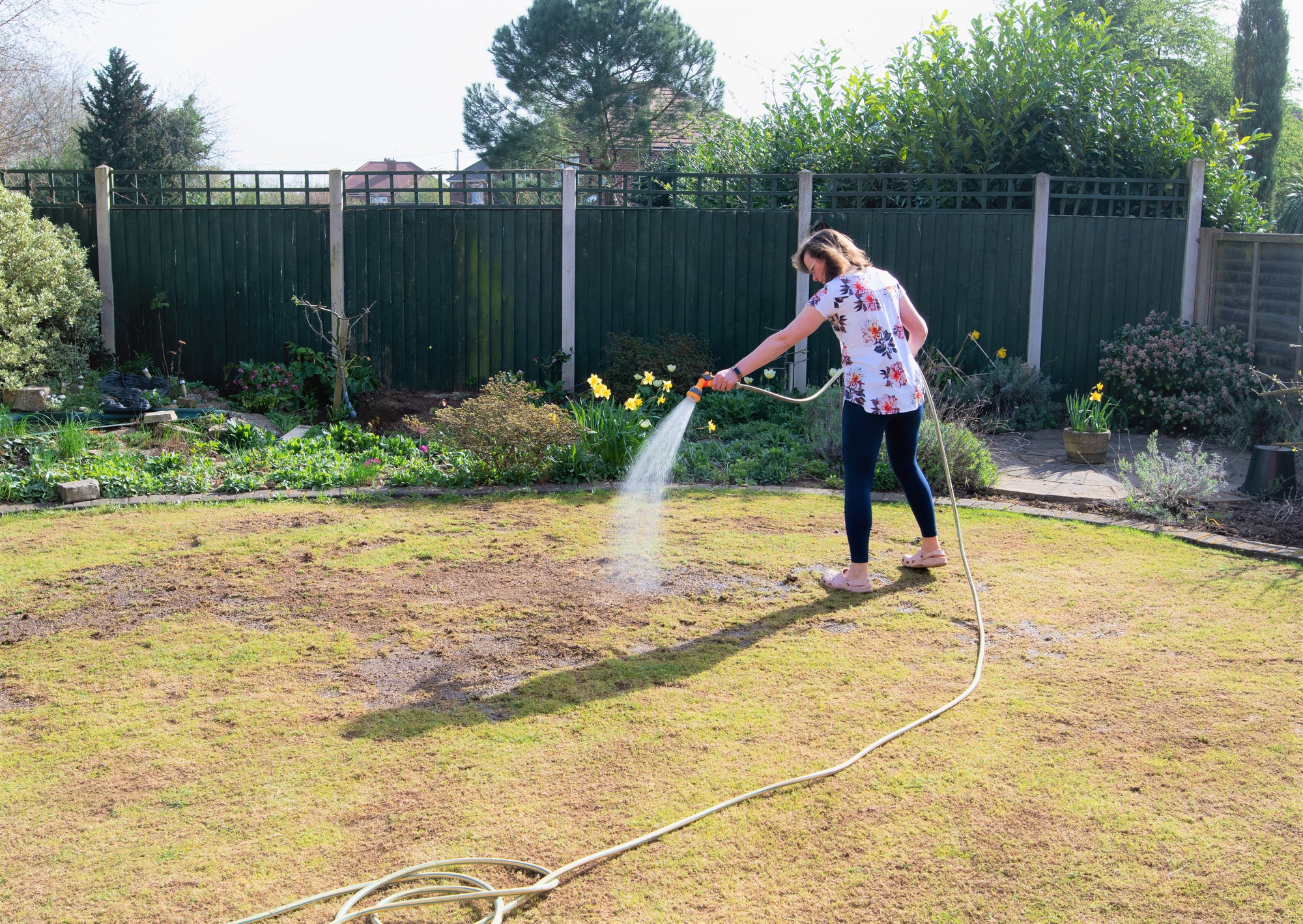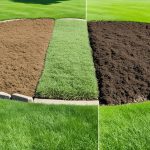As the weather starts to warm up, many homeowners are looking ahead to summer and wondering if their lawns are ready for the heat. A healthy lawn can withstand higher temperatures and reduced rainfall, but one that’s already struggling may suffer significant damage during hot weather. Recognising the warning signs early gives you time to address problems before they worsen.
Taking action now can save you both time and money while ensuring your lawn remains green and vibrant throughout the summer months. Most lawn issues can be resolved with proper care and attention, but it’s important to identify problems quickly. From yellowing patches to poor growth patterns, your lawn communicates its needs through visible signals that even novice gardeners can learn to spot.
1) Brown patches spreading rapidly
One of the first indicators that your lawn needs immediate attention is the appearance of brown patches that begin to spread. These discoloured areas often signal underlying health issues that can worsen quickly as temperatures rise.
Brown patches may start small but can expand across your entire lawn within days if not addressed. The rapid spread typically points to fungal diseases, insect infestations, or severe nutrient deficiencies rather than simple drought stress.
Fungal problems like brown patch disease thrive in warm, humid conditions and can devastate a lawn before summer fully arrives. When you notice these spreading patches, check the affected grass blades for dark rings or spots that might confirm a fungal issue.
Insect damage from grubs or chinch bugs can also create brown areas that expand as the pests multiply. Look closely at the soil in affected areas to spot any unwanted visitors.
Addressing these patches quickly is essential before hot weather intensifies the problem. Proper diagnosis is the key first step, as treatments for fungi differ significantly from those for insect control.
2) Thinning grass and visible soil
When patches of soil become visible through your lawn, it’s a clear warning sign that your grass is struggling. Healthy lawns typically have dense growth that covers the soil completely. If you can easily see the ground between grass blades, your lawn is thinning and needs attention.
Several factors can cause thinning, including poor soil conditions, improper mowing practices, and inadequate watering. Compacted soil prevents grass roots from accessing nutrients and water, leading to weakened growth and bare spots.
Pest damage and disease can also create thin areas in your lawn. Look for irregular patterns of thinning, which often indicate insect activity beneath the surface. Fungal issues frequently appear as circular patches where grass has disappeared.
Before summer heat arrives, take action by aerating compacted soil and overseeding thin areas. Adding a thin layer of quality topsoil or compost can improve growing conditions and help new seed establish quickly.
Regular, deep watering rather than frequent light sprinkles encourages deeper root growth. This helps your grass become more resilient to heat stress and drought conditions that summer brings.
3) Grass blades curling and wilting
Curling and wilting grass blades are clear signals that your lawn is under stress and needs attention before summer heat arrives. This condition often indicates that your grass isn’t getting enough water to maintain proper cell structure.
When grass becomes dehydrated, the blades fold inward to reduce water loss through transpiration. This defensive mechanism helps the plant survive, but it’s a warning sign that shouldn’t be ignored.
You might notice this wilting first in areas that receive more sun or on slopes where water runs off quickly. These stressed areas will appear duller than healthy grass and may feel crunchy underfoot.
Morning is the best time to check for wilting, as afternoon heat can cause temporary wilting even in well-watered lawns. If the grass doesn’t recover by evening or early morning, your lawn is genuinely thirsty.
Increasing your watering schedule is the immediate solution, but do so properly. Water deeply and less frequently rather than lightly and often. This encourages deeper root growth, which helps grass withstand future dry spells.
4) Increased presence of lawn pests
Pests can be a clear warning sign that your lawn needs attention before summer heat arrives. Common lawn pests include grubs, chinch bugs, armyworms, and various beetles that feed on grass roots and blades.
These unwanted visitors often appear when grass is already stressed or weakened. They take advantage of thinning areas and poor root development, making existing problems worse.
Look for irregular brown patches that don’t respond to watering, small holes throughout the lawn, or visible insects when you part the grass. Birds suddenly showing interest in your lawn might also indicate a pest problem below the surface.
Early identification is key to preventing severe damage. If you spot these signs, consider applying appropriate pest control measures suited to the specific invaders you’ve identified.
Healthy, thick grass naturally resists pest infestations better than weak turf. Proper fertilisation, correct mowing height, and appropriate watering can help create conditions less favourable to pests.
Some beneficial insects like ladybirds actually help control harmful pests, so complete elimination of all insects isn’t necessary or desirable for a balanced lawn ecosystem.
5) Yellowing of grass tips
When grass tips turn yellow, your lawn is sending a clear distress signal. This discolouration often indicates nutrient deficiencies, particularly a lack of nitrogen which is essential for maintaining that rich green colour.
Yellow tips can also result from improper watering practices. Too little water causes stress, while excessive watering might wash away vital nutrients from the soil.
Another common cause is dull mower blades. When blades aren’t sharp, they tear the grass rather than cut it cleanly, leaving damaged tips that turn yellow and become vulnerable to disease.
Soil pH imbalance may also contribute to yellowing tips. When soil is too acidic or too alkaline, grass cannot properly absorb the nutrients it needs, even if they’re present in the soil.
Before summer heat arrives, address yellowing tips by testing your soil, adjusting your watering schedule, and ensuring your mower is properly maintained. A targeted fertiliser application based on your soil test results can help restore proper nutrient levels.
6) Soil feels dry more than an inch down
Proper soil moisture is essential for lawn health. If your soil feels dry when you insert your finger more than an inch below the surface, your grass may be struggling to access water at the root level.
This dryness can occur even after regular watering if the water isn’t penetrating deeply enough. Short, frequent watering sessions often only wet the surface, leaving deeper soil dry and roots stressed.
To test moisture depth, use a simple soil probe or even a screwdriver. If it doesn’t slide easily into the soil, you likely have dry conditions below the surface.
Sandy soils drain quickly and may need more frequent watering. Clay soils can sometimes repel water after becoming very dry, creating a condition called hydrophobic soil.
Adding organic matter to your soil can help improve water retention. Consider core aeration to create channels for water to reach deeper into the soil profile.
Adjusting your watering schedule before summer heat arrives is vital. Water deeply but less frequently to encourage roots to grow downward in search of moisture.
7) Uneven lawn growth patterns
When your lawn shows patches of different heights or thickness, it’s signalling a problem. These irregular growth patterns often indicate soil issues, watering problems, or pest activity beneath the surface.
Soil compaction in high-traffic areas can lead to stunted grass growth. Meanwhile, areas with better soil quality may show lusher, taller grass, creating an uneven appearance across your lawn.
Improper fertiliser application is another common cause. Too much fertiliser in some spots and too little in others results in varied growth rates and colour differences.
Underground obstacles like rocks, old construction debris, or tree roots can also create uneven growth. These barriers prevent proper root development in affected areas.
Before summer heat arrives, address these issues by aerating compacted soil and applying fertiliser evenly. Consider soil testing to identify specific nutrient deficiencies in problem areas.
For severe cases, you might need to remove underground obstacles or add topsoil to level the lawn. Correcting these issues before hot weather arrives gives your grass the best chance to develop evenly and withstand summer stress.
8) Difficult to push a screwdriver into soil
Compacted soil creates problems for your lawn that become particularly noticeable as summer approaches. A simple test can reveal this issue: try pushing a screwdriver into your soil. If it’s difficult to insert, your soil is likely too dense.
Compacted soil prevents proper water absorption, root growth and nutrient distribution. This becomes especially problematic during hot weather when your grass needs easy access to water and nutrients to survive.
Hard soil occurs from foot traffic, heavy equipment use or clay-heavy soil composition. When left untreated, compacted areas will develop brown patches during summer heat as roots struggle to access deeper moisture reserves.
The solution involves aerating your lawn to create channels for air, water and nutrients. For smaller lawns, a manual aerator tool works effectively. Larger properties may require a mechanical aerator, available from garden centres or tool hire shops.
After aerating, apply a top dressing of compost to improve soil structure. Water deeply but infrequently to encourage roots to grow downward. Taking these steps before summer arrives gives your lawn the best chance to develop strong root systems capable of withstanding heat stress.
Understanding Your Lawn’s Seasonal Needs
Lawns require different care approaches as the seasons change. Pre-summer preparation is particularly important to ensure your grass can withstand heat stress and maintain its health during the challenging summer months.
The Science Behind Pre-Summer Lawn Care
Grass plants undergo physiological changes as temperatures rise. In spring, cool-season grasses experience their primary growth period, developing deeper root systems that will help them access water during summer heat. These roots can only grow properly when soil temperatures remain between 10-18°C.
Water management becomes critical during the transition to summer. Grass roots need consistent moisture to develop properly, but overwatering can lead to shallow root growth. This makes lawns more vulnerable to drought stress later.
Soil biology also changes seasonally. Spring’s moderate temperatures support beneficial microorganisms that break down thatch and improve nutrient availability. These microbes work most effectively when:
- Soil pH is between 6.0-7.0
- Organic matter is present
- Soil isn’t compacted
Nutrient requirements shift too. Pre-summer lawns need balanced nutrition with slightly higher nitrogen to support leaf growth before the stress period begins.
Key Differences Between Spring and Summer Lawn Maintenance
Mowing practices should change as seasons transition. In spring, keeping grass at a medium height encourages root development. As summer approaches, raising the cutting height by about 1.5 cm helps shade soil and reduces water evaporation.
Watering frequency and timing differ dramatically. Spring lawns typically need less supplemental water due to natural rainfall and lower evaporation rates. As temperatures rise, shift to deeper, less frequent watering sessions in early morning to minimise fungal disease risks.
Fertilisation requirements change too. Spring applications focus on balanced nutrients supporting overall growth. Pre-summer feeding should emphasise potassium and phosphorus to build heat tolerance and root strength.
Pest and disease management priorities shift:
- Spring: Focus on preventing weeds and early-season insects
- Pre-summer: Monitor for signs of fungal diseases that thrive in warm, humid conditions
Aeration and dethatching are best completed in spring before summer heat adds stress to recovering grass plants.
Proactive Strategies to Strengthen Your Grass
Preparing your lawn before summer heat arrives can prevent stress damage and keep grass healthy throughout the hottest months. These preventative measures will build resilience into your turf system when properly implemented.
Effective Watering Methods for Early Warm Weather
Deep, infrequent watering encourages grass roots to grow deeper into the soil. Water your lawn 1-2 times per week with 2.5-4 cm of water rather than daily light sprinklings. This approach helps grass develop stronger drought resistance.
The best time to water is early morning between 4-10am. This allows moisture to soak in before evaporation and reduces disease risk that comes with evening watering.
Consider installing a rain gauge to measure exactly how much water your lawn receives. Many homeowners unknowingly under-water their grass.
For sloped areas, use a sprinkler with a slower flow rate or water in shorter, repeated cycles to prevent runoff and ensure proper absorption.
Selecting and Applying Lawn Feed Before Heatwaves
Choose a slow-release fertiliser with balanced NPK ratios (nitrogen, phosphorus, potassium) appropriate for spring application. Products with higher potassium content help grass withstand heat stress and drought conditions.
Apply fertiliser when the soil is moist but the grass is dry. This prevents burning and ensures nutrients can be properly absorbed by the roots.
For best results, follow package instructions regarding application rates. Over-fertilising can damage grass and create weak growth that’s more susceptible to heat damage.
Consider a soil test before fertilising to identify specific nutrient deficiencies. This prevents wasteful application of unneeded nutrients and ensures your grass gets exactly what it requires.
Many experts recommend applying iron supplements in late spring to strengthen grass blades before summer heat arrives.





